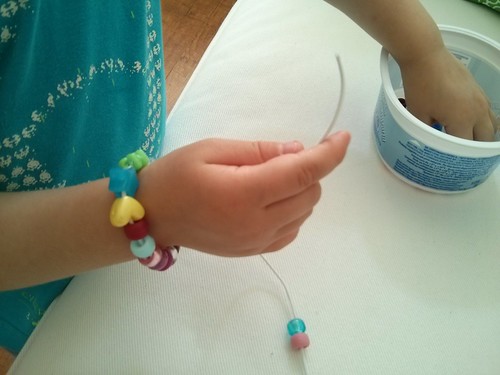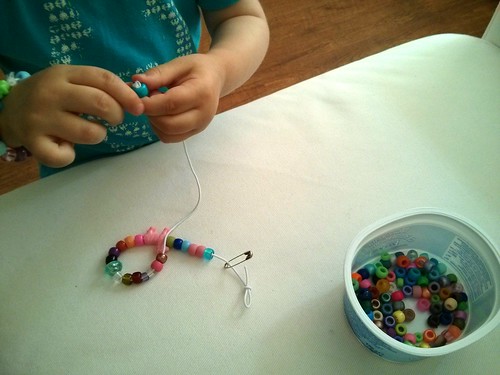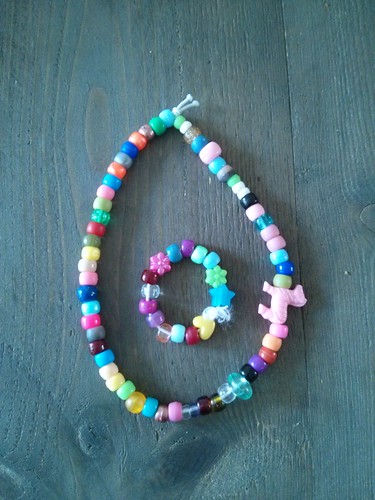
Pocket Purses
Little button or snap closure pocket purses are endlessly useful. You can tuck a few important things in that you don't want lost at the bottom of a larger bag, use them to store jewellery when travelling, use them for keeping crafty odds and ends tidy, or for any number of other things. You could even use it as a small clutch purse on its own. I've been teaching a friend of mine to sew and she mentioned a desire to make something like this, so I said I'd write a tutorial for one and then we could sew it together.
These are pretty quick to make (if you're not taking photos of every single step) and I probably spend nearly as much time dithering over the button choice as I do actually sewing!
Materials:
- 1 piece outer fabric (6.5 inches x 12 inches)
- 1 piece lining fabric (6.5 inches x 12 inches)
- 1 piece heavyweight interfacing (6 inches x 11.5 inches)
- 1 button (or snap)
The finished purse is approximately 6 inches by 4.5 inches and it uses 1/4 inch seams throughout.

Pocket Purse Materials
A note on adjusting the size:
You can easily make this purse smaller or larger if you have something specific you want to store in it. Just adjust the initial size of the rectangles, and make sure the interfacing does not include the seam allowance. If you want finished dimensions of W (width) x H (height), cut out your fabric in rectangles of W + 0.5" by (H x 2 + H/2) + 0.5". This should make a pocket purse with a flap that's half the finished height. So, if you want to make a pocket that's 8 x 4 inches (with a 2 inch flap), you would cut your fabric in 8.5" x 10.5" rectangles.
Step 1: Iron interfacing to outer fabric

Interfacing
Iron your interfacing to the wrong side of your outer fabric, leaving 1/4 inch seam allowance on all sides.
Step 2: Sew pocket with outer fabric

Sew outer pocket
With right side facing up, fold the bottom edge of your outer fabric up, so that right sides will be together. The doubled portion should be 4 1/2 inches high, leaving 3 inches showing for the flap. If you want your flap longer or shorter, you can adjust it at this point. Pin the fabric in place and sew up each side of the doubled fabric, leaving the top 1/4 inch free (so just sew alongside the interfacing). Always back stitch at the start and end to secure your sewing.
Step 3: Sew pocket with lining fabric

Sew lining pocket
Repeat Step 2, with the lining fabric. You may want to mark a point 1/4 inch before the end of the doubled fabric since you won't have the interfacing to guide you where to stop. After sewing, snip the bottom corners with pinking shears and iron the seam open, facing in (i.e. just the top part of the seam allowance gets ironed towards the middle, so that it overlaps the pocket).

Finished lining pocket
Step 4: Insert lining

Insert lining
Flip the lining right side out (optionally iron the seams crisp) and tuck it inside the outer fabric. The right sides of your two fabrics should be together. Pin them together, paying special attention to the start of the flap, since the lining fabric will want to curl inwards.
Step 5: Sew across pocket

sew across pocket
Sew the outer fabric to the lining, across the top of the pocket. Just sew alongside the interfacing, making sure that you're only sewing the top two layers. A free-arm sewing machine makes this easiest.

sewing across pocket
Step 6: Sew around flap, leaving opening for turning

move pins to back
Now you're going to sew around the flap, leaving a 3 inch gap in the middle for turning. I found it easiest to flip the pocket over, moving the pins to that side, and to sew following the interfacing. Make an extra strong back stitch on either side of the gap so it can withstand the strain of turning. Be sure to sew all the way down to meet the seams along the lower portion of the sides. Try not to catch the edge of the pocket seam allowance like I did (but don't worry if you do as it will be hidden when the purse is flipped right side out).

sew flap, leave gap
Step 7: Trim and iron

Trim and iron
Trim the corners of the purse with pinking shears and iron back the seam allowance along the top of the flap. This will make hand-sewing the opening easier. (If you plan to use a snap rather than button, I recommend that you iron on a scrap bit of interfacing to the lining on the part of the flap where the snap will go. This will help prevent the snap from pulling too much at the fabric.)
Step 8: Flip purse and sew up opening

Flip right side out
Using the gap that you left un-sewn, flip the purse right-side out. (It will look a bit like a strange hand-puppet until you tuck the lining inside the outer fabric to create your pocket.) Using a
ladder stitch, hand sew the opening in the flap closed. Fold the flap down and iron to crease.

Pocket Purse before button
Step 9: Add button or snap

Choosing a button
Choose a button (fun, but takes me forever!) and decide where you'd like it placed. Mark discreetly with a fabric pencil and sew a buttonhole in the flap. I always do a tester on scrap fabric first! Hand sew your button in the appropriate place on the pocket. Alternately, you can attach a snap instead of a button, following the directions on the package of snaps.

Mark button placement
If all has gone well, you should now have a cute little pocket purse, ready for all your bits and pieces!
If you make a pocket purse following this tutorial, I'd love to see it! Please add your pictures to my
flickr group.

Finished Pocket Purse
Photographs and artwork by Allison Gryski. © All rights reserved.


























































